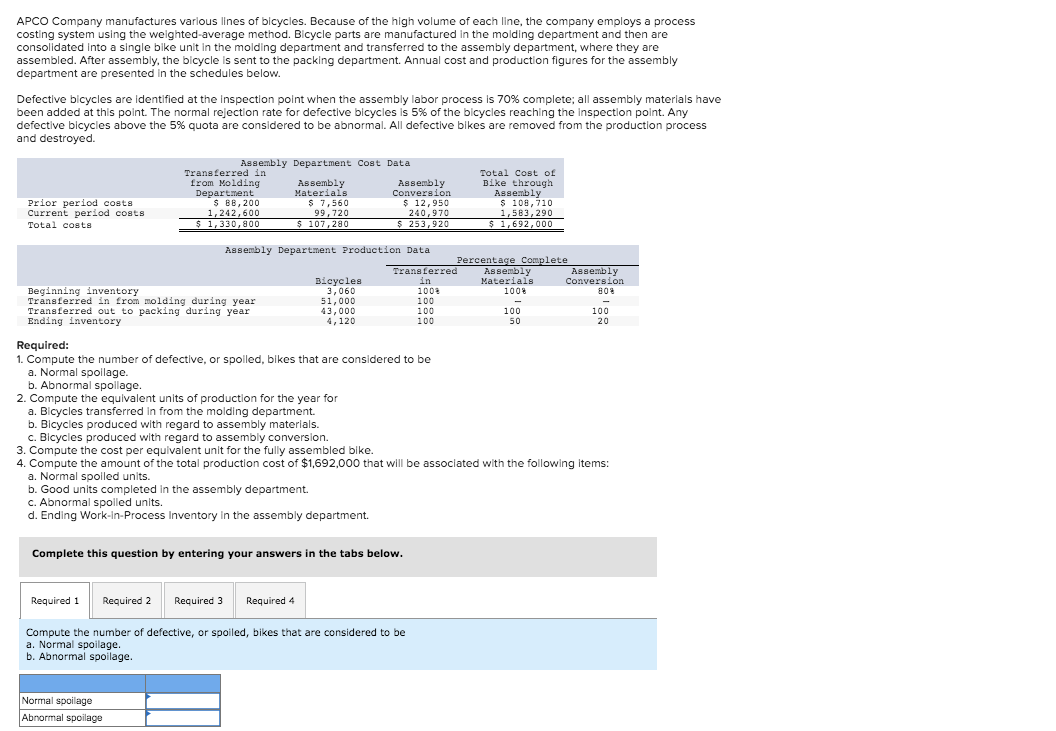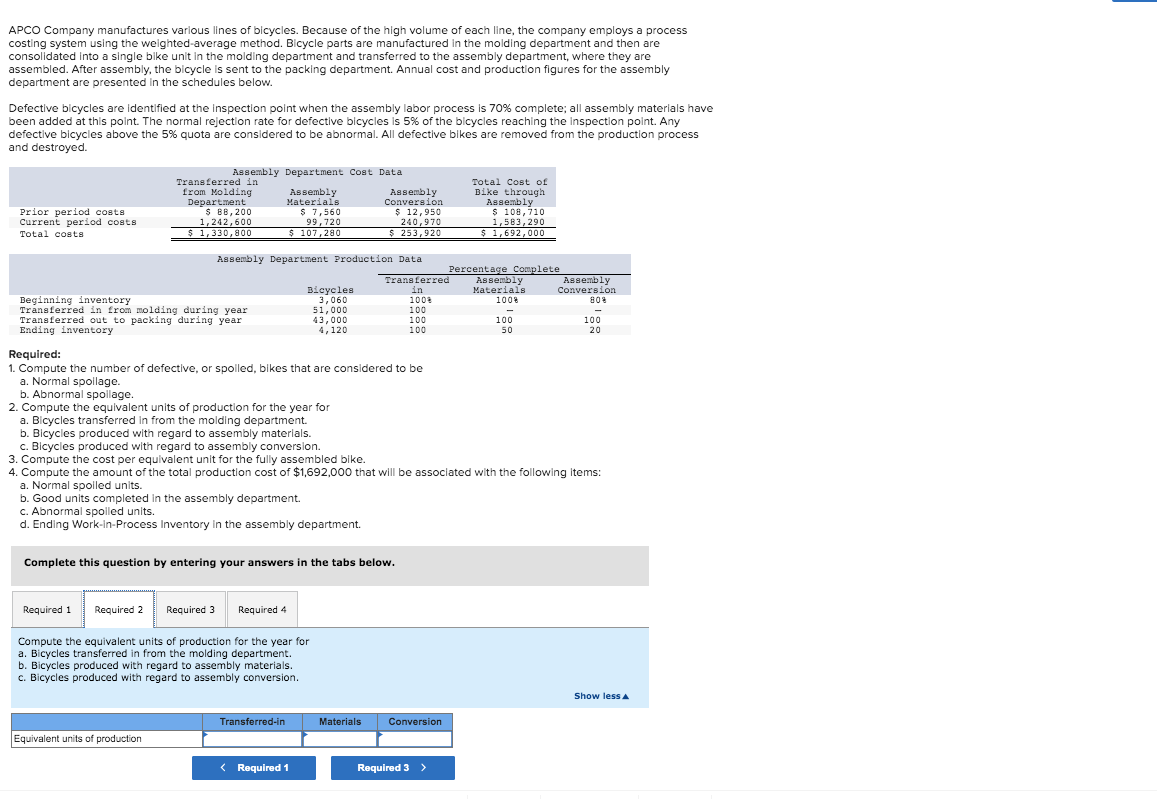



APCO Company manufactures various lines of bicycles. Because of the high volume of each line, the company employs a process costing system using the weighted average method. Bicycle parts are manufactured in the molding department and then are consolidated into a single bike unit in the molding department and transferred to the assembly department, where they are assembled. After assembly, the bicycle is sent to the packing department. Annual cost and production figures for the assembly department are presented in the schedules below. Defective bicycles are identified at the inspection point when the assembly labor process is 70% complete; all assembly materials have been added at this point. The normal rejection rate for defective bicycles is 5% of the bicycles reaching the inspection point. Any defective bicycles above the 5% quota are considered to be abnormal. All defective bikes are removed from the production process and destroyed. Assembly Department Cost Data Transferred in from Molding Assembly Assembly Department Materials Conversion $ BB,200 $ 7,560 $ 12,950 1,242,600 99,720 240,970 $ 1,330,800 $ 107,280 $ 253,920 Prior period costs Current period costs Total costs Total cost of Bike through Assembly $ 108,710 1,583,290 $ 1,692,000 Assembly Department Production Data Percentage Complete Transferred Assembly Assembly Bicycles in Materials Conversion Beginning inventory 3,060 1002 100% 808 Transferred in from molding during year 51,000 100 Transferred out to packing during year 43,000 100 100 100 Ending inventory 4,120 100 50 20 Required: 1. Compute the number of defective, or spoiled, bikes that are considered to be a. Normal spoilage b. Abnormal spoilage. 2. Compute the equivalent units of production for the year for a. Bicycles transferred in from the molding department. b. Bicycles produced with regard to assembly materials. c. Bicycles produced with regard to assembly conversion. 3. Compute the cost per equivalent unit for the fully assembled bike. 4. Compute the amount of the total production cost of $1,692,000 that will be associated with the following items: a. Normal spoiled units. b. Good units completed in the assembly department. c. Abnormal spoiled units. d. Ending Work-in-Process Inventory in the assembly department. Complete this question by entering your answers in the tabs below. Required 1 Required 2 Required 3 Required 4 Compute the number of defective, or spoiled, bikes that are considered to be a. Normal spoilage. b. Abnormal spoilage. Normal spoilage Abnormal spoilago APCO Company manufactures various lines of bicycles. Because of the high volume of each line, the company employs a process costing system using the weighted average method. Bicycle parts are manufactured in the molding department and then are consolidated into a single bike unit in the molding department and transferred to the assembly department, where they are assembled. After assembly, the bicycle is sent to the packing department. Annual cost and production figures for the assembly department are presented in the schedules below. Defective bicycles are identified at the inspection point when the assembly labor process is 70% complete; all assembly materials have been added at this point. The normal rejection rate for defective bicycles is 5% of the bicycles reaching the inspection point. Any defective bicycles above the 5% quota are considered to be abnormal. All defective bikes are removed from the production process and destroyed. Assembly Department Cost Data Transferred in from Molding Assembly Assembly Department Materials Conversion S BB, 200 $ 7,560 $ 12,950 1,242,600 99,720 240,970 $ 1,330,800 $ 107,280 $ 253, 920 Prior period coats Current period costs Total costa Total cost of Bike through Assembly $ 108,710 1,583,290 $ 1,692,000 Assembly Department Production Data Percentage Complete Transferred Assembly Assembly Bicycles in Materials Conversion Beginning inventory 3,060 1008 100% 808 Transferred in from molding during year 51,000 100 Transferred out to packing during year 43,000 100 100 100 100 09 Ending inventory 4, 120 100 50 20 Required: 1. Compute the number of defective, or spoiled, bikes that are considered to be a. Normal spoilage. b. Abnormal spollage. 2. Compute the equivalent units of production for the year for a. Bicycles transferred in from the molding department. b. Bicycles produced with regard to assembly materials. c. Bicycles produced with regard to assembly conversion. 3. Compute the cost per equivalent unit for the fully assembled bike. 4. Compute the amount of the total production cost of $1,692,000 that will be associated with the following items: a. Normal spoiled units. b. Good units completed in the assembly department. c. Abnormal spoiled units. d. Ending Work-in-Process Inventory in the assembly department. Complete this question by entering your answers in the tabs below. Required 1 Required 2 Required 3 Required 4 Compute the equivalent units of production for the year for a. Bicycles transferred in from the molding department. b. Bicycles produced with regard to assembly materials. c. Bicycles produced with regard to assembly conversion. Show less Transferred-in - Materials Conversion Equivalent units of production APCO Company manufactures various lines of bicycles. Because of the high volume of each line, the company employs a process costing system using the weighted average method. Bicycle parts are manufactured in the molding department and then are consolidated into a single bike unit in the molding department and transferred to the assembly department, where they are assembled. After assembly, the bicycle is sent to the packing department. Annual cost and production figures for the assembly department are presented in the schedules below. Defective bicycles are identified at the inspection point when the assembly labor process is 70% complete; all assembly materials have been added at this point. The normal rejection rate for defective bicycles is 5% of the bicycles reaching the inspection point. Any defective bicycles above the 5% quota are considered to be abnormal. All defective bikes are removed from the production process and destroyed. Assembly Department Cost Data Transferred in Total cost of from Molding Assembly Assembly Bike through Department Materials Conversion Assembly Prior period costs $ BB,200 $ 7,560 $ 12,950 $ 108,710 Current period costs 1,242,600 99,720 240,970 1,583,290 Total costs $ 1,330,800 $ 107,280 $ 253, 920 $ 1,692,000 Assembly Department Production Data Percentage Complete Transferred Assembly Assembly Bicycles in Materials Conversion Beginning inventory 3,060 1000 100 808 Transferred in from molding during year 51,000 100 Transferred out to packing during year 43,000 100 100 100 Ending inventory 4,120 100 50 20 Required: 1. Compute the number of defective, or spoiled, bikes that are considered to be a. Normal spoilage. b. Abnormal spoilage. 2. Compute the equivalent units of production for the year for a. Bicycles transferred in from the molding department. b. Bicycles produced with regard to assembly materials. c. Bicycles produced with regard to assembly conversion. 3. Compute the cost per equivalent unit for the fully assembled bike. 4. Compute the amount of the total production cost of $1,692,000 that will be associated with the following items: a. Normal spoiled units. b. Good units completed in the assembly department c. Abnormal spoiled units. d. Ending Work-in-Process Inventory in the assembly department. Complete this question by entering your answers in the tabs below. Required 1 1 Required 2 Required 3 Required 4 Compute the cost per equivalent unit for the fully assembled bike. (Round your intermediate calculations and final answer to 2 decimal places.) Cost per equivalent unit Defective bicycles are identified at the Inspection point when the assembly labor process is 70% complete; all assembly materials have been added at this point. The normal rejection rate for defective bicycles is 5% of the bicycles reaching the inspection point. Any defective bicycles above the 5% quota are considered to be abnormal. All defective bikes are removed from the production process and destroyed. Assembly Department Cost Data Transferred in from Molding Assembly Assembly Department Materials Conversion $ BB, 200 $ 7,560 $ 12,950 1,242,600 99,720 240,970 $ 1,330,800 $ 107,280 $ 253, 920 Prior period costs Current period costs Total costs Total cost of Bike through Assembly $ 108,710 1,583,290 $ 1,692,000 Assembly Department Production Data Percentage Complete Transferred Assembly Assembly Bicycles in Materials Conversion Beginning inventory 3,060 1000 100% 808 Transferred in from molding during year 51,000 100 Transferred out to packing during year 43,000 100 100 100 Ending inventory 4,120 100 50 20 Required: 1. Compute the number of defective, or spoiled, bikes that are considered to be a. Normal spollage. b. Abnormal spoilage. 2. Compute the equivalent units of production for the year for a. Bicycles transferred in from the molding department. b. Bicycles produced with regard to assembly materials. c. Bicycles produced with regard to assembly conversion. 3. Compute the cost per equivalent unit for the fully assembled bike. 4. Compute the amount of the total production cost of $1,692,000 that will be associated with the following items! a. Normal spoiled units. b. Good units completed in the assembly department. c. Abnormal spoiled units. d. Ending Work-in-Process Inventory in the assembly department. -. Complete this question by entering your answers in the tabs below. Required 1 Required 2 Required 3 Required 4 Compute the amount of the total production cost of $1,692,000 that will be associated with the following items: a. Normal spoiled units. b. Good units completed in the assembly department. c. Abnormal spoiled units. d. Ending Work-in-Process Inventory in the assembly department. (Round your intermediate calculations to 2 decimal places and final answers to the nearest whole dollar amount.) Show less Normal spoilage Good units completed in the assembly department Abnormal spoilage Ending work-in-process inventory APCO Company manufactures various lines of bicycles. Because of the high volume of each line, the company employs a process costing system using the weighted average method. Bicycle parts are manufactured in the molding department and then are consolidated into a single bike unit in the molding department and transferred to the assembly department, where they are assembled. After assembly, the bicycle is sent to the packing department. Annual cost and production figures for the assembly department are presented in the schedules below. Defective bicycles are identified at the inspection point when the assembly labor process is 70% complete; all assembly materials have been added at this point. The normal rejection rate for defective bicycles is 5% of the bicycles reaching the inspection point. Any defective bicycles above the 5% quota are considered to be abnormal. All defective bikes are removed from the production process and destroyed. Assembly Department Cost Data Transferred in Total cost of from Molding Assembly Assembly Bike through Department Materials Conversion Assembly Prior period costs $ BB,200 $ 7,560 $ 12,950 $ 108,710 Current period costs 1,242,600 99,720 240,970 1,583,290 Total costs $ 1,330,800 $ 107,280 $ 253, 920 $ 1,692,000 Assembly Department Production Data Percentage Complete Transferred Assembly Assembly Bicycles in Materials Conversion Beginning inventory 3,060 1000 100 808 Transferred in from molding during year 51,000 100 Transferred out to packing during year 43,000 100 100 100 Ending inventory 4,120 100 50 20 Required: 1. Compute the number of defective, or spoiled, bikes that are considered to be a. Normal spoilage. b. Abnormal spoilage. 2. Compute the equivalent units of production for the year for a. Bicycles transferred in from the molding department. b. Bicycles produced with regard to assembly materials. c. Bicycles produced with regard to assembly conversion. 3. Compute the cost per equivalent unit for the fully assembled bike. 4. Compute the amount of the total production cost of $1,692,000 that will be associated with the following items: a. Normal spoiled units. b. Good units completed in the assembly department c. Abnormal spoiled units. d. Ending Work-in-Process Inventory in the assembly department. Complete this question by entering your answers in the tabs below. Required 1 1 Required 2 Required 3 Required 4 Compute the cost per equivalent unit for the fully assembled bike. (Round your intermediate calculations and final answer to 2 decimal places.) Cost per equivalent unit Defective bicycles are identified at the Inspection point when the assembly labor process is 70% complete; all assembly materials have been added at this point. The normal rejection rate for defective bicycles is 5% of the bicycles reaching the inspection point. Any defective bicycles above the 5% quota are considered to be abnormal. All defective bikes are removed from the production process and destroyed. Assembly Department Cost Data Transferred in from Molding Assembly Assembly Department Materials Conversion $ BB, 200 $ 7,560 $ 12,950 1,242,600 99,720 240,970 $ 1,330,800 $ 107,280 $ 253, 920 Prior period costs Current period costs Total costs Total cost of Bike through Assembly $ 108,710 1,583,290 $ 1,692,000 Assembly Department Production Data Percentage Complete Transferred Assembly Assembly Bicycles in Materials Conversion Beginning inventory 3,060 1000 100% 808 Transferred in from molding during year 51,000 100 Transferred out to packing during year 43,000 100 100 100 Ending inventory 4,120 100 50 20 Required: 1. Compute the number of defective, or spoiled, bikes that are considered to be a. Normal spollage. b. Abnormal spoilage. 2. Compute the equivalent units of production for the year for a. Bicycles transferred in from the molding department. b. Bicycles produced with regard to assembly materials. c. Bicycles produced with regard to assembly conversion. 3. Compute the cost per equivalent unit for the fully assembled bike. 4. Compute the amount of the total production cost of $1,692,000 that will be associated with the following items! a. Normal spoiled units. b. Good units completed in the assembly department. c. Abnormal spoiled units. d. Ending Work-in-Process Inventory in the assembly department. -. Complete this question by entering your answers in the tabs below. Required 1 Required 2 Required 3 Required 4 Compute the amount of the total production cost of $1,692,000 that will be associated with the following items: a. Normal spoiled units. b. Good units completed in the assembly department. c. Abnormal spoiled units. d. Ending Work-in-Process Inventory in the assembly department. (Round your intermediate calculations to 2 decimal places and final answers to the nearest whole dollar amount.) Show less Normal spoilage Good units completed in the assembly department Abnormal spoilage Ending work-in-process inventory










